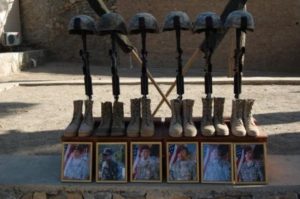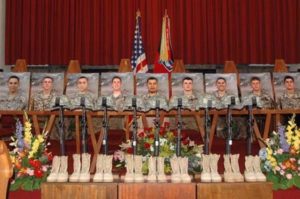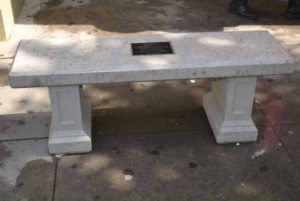November Great Story by Steven Kerns, Southern California Water Fellow
My great story for this month has to do with an essay I spent 29 years preparing to write. You see, part of the law-school application process is writing a deeply important personal statement, often without a prompt – “Tell us, in 4 pages who you are and why you deserve to come to our law-school.” Bare everything you’ve got in hopes that your condensed life-history is worthy of attending a school; alright, you’ve got it!
So as this has been a key-point in my life, my “great story” for this month is my own…without further adieu, here is my story.
I cannot say that I joined the military for purely patriotic reasons, or that I, at the time, even possessed the maturity to understand what serving the greater good really meant. Armed with a desire to create positive changes in the world and romantic notions about defining my character, I committed to something much larger than myself and began the journey of a lifetime.
My unit deployed to Afghanistan with the 173rd Airborne in May 2007 in support of Operation Enduring Freedom, the longest war in United States history. Chosen Company was spread across the mountainous provinces of Kunar and Nuristan. These regions came to see some of the worst fighting in the war’s history. The serrated valleys that formed rock crags reduced our sky to mere slivers; these were literal mountains of intimidation. Step by step, we traversed the mountains and by doing so it felt as if we had conquered mountains within ourselves. Reality soon tempered our illusions of grandeur.
Photo Left to Right: Fellow Steven Kerns, Nuristan Province, Afghanistan; Steven Kerns in Weapons Squad, 1st Platoon FOB Ranch House, Afghanistan.
During a patrol on November 9th 2007, two squads from my platoon were returning home from talks with the local Afghans about building a school in the nearby Aranas Valley. Both squads were caught in a close-ambush, many of those men were brutally killed. During this time, I was with the rest of my platoon fighting for our lives against an all-out assault on our base. After we repelled the attack we were ordered not to assist those who had been ambushed, as doing so would pose too much of a strategic risk. They were less than a kilometer away. Their voices haunted our radios. In a maelstrom of personal desires and emotions, choosing to abandon our men to serve the greater good seemed a Pyrrhic victory.
We were given the better part of the following day to deal with the fallout; their blood still stained our gear from the recovery mission. I was unable to distance myself from the moment when I felt the first body twisted by rigor mortis. The shadow of death followed me out of the valley, its cruelty weaved its way into everything. Two days later, we held a memorial service for our fallen. We were being forced to bury the profound tragedy of our lives. “Move on, you’ve got patrol.”
As I found myself growing colder and harder from my life as a soldier, community became the difference between post-traumatic stress and post-traumatic growth. The support of a community bonded by war, in the aftermath tragedy, was invaluable to me. Sergeant Israel Garcia was in a different platoon and older than I, but the Army brought us together. We discovered we grew up in the same city, attended the same high-school, and shared our most precious resource, home. On July 13th 2008, at the battle of Wanat, Sergeant Garcia earned the Silver Star for his bravery but he did not survive the battle. After I returned home, a sense of loyalty drove me to honor his memory. I felt that through doing this I could indirectly honor the men I had been ordered to abandon. I asked our High School to build a memorial bench on our campus. At first, the school district rejected the proposal, citing funding and the need for organizational approval. I was undeterred, and after overcoming the hurdles to obtain permission, I started fundraising.
Photo Left to Right: Memorial for those killed in the November 9th ambush; Memorial honoring those slain at the Battle of Wanat.
I realized I could unite communities and by tearing down the cultural differences between them, I achieved a goal larger than myself. I organized my friends into a movement capable of bringing together diverse groups such as U.S.VETS, Don Knabe of the Los Angeles County Board of Supervisors, celebrated artists like Ruth Mayer, and many prominent Los Angeles musicians. I turned $500 in personal donations into over $5500. After meeting the costs of the bench, the decision was made to donate the remaining balance to U.S. VETS. Through the mobilization of my social network, I witnessed how compassion and empathy could create tangible differences within and beyond my community. On May 25th 2012, as the bench was unveiled, I saw the effect our efforts had on Israel’s family. This experience allowed me to begin leaving the war behind me as I knew that I could lead people to positive changes in our society.
Leading people towards a better world requires more than just virtues, experiences, and aspirations; it requires an education. I have traded my rifle in for books and replaced the unfocused ambition of my youth for the dedication of my life. I am devoted to narrowing the divide between science and public policy in hopes that data, not politics, will dictate our environmental policy. To embody this philosophy, I have pursued opportunities that would allow me to understand both communities. To complement my scientific education, I began interning with different levels of local government. I gained mentors who had powerful effects on who I became. These positions also allowed me to help veterans who were struggling within our community, plant trees in underprivileged neighborhoods which didn’t have them, and learn directly from experience how our government operates. Inspired by the value of these experiences and supported by my mentors, I began to apply science beyond the classroom.
Photo Left to Right: Bench and plaque at Long Beach Polytechnic High-School dedicated to Sergeant Israel Garcia.
Through a lingering thousand-yard stare and the window of a Costa Rican bus that was more weathered than the elements, I saw the beauty of the rainforest. It stirred in me a deeper appreciation for the natural world that has grown into my love for all living things. Juxtaposed against the vibrant green life-force of the rain-forest, the echoes of war faded away. Our research team provided evidence-based scientific data on the positive ecological impact of trees, with the aspiration of using this as leverage to foster new values in policy-makers, maybe even stop deforestation. I know that current projections suggest most of our world’s rainforests will be gone by 2030. I witnessed the open wound where forests had been replaced by multi-national pineapple plantations. I have chosen environmental law because I know what is at stake.
To sustain peace in our future, we must act boldly but effectively when dealing with the environmental destruction we have wrought, and the instability that follows in its wake. This will require unifying the scientific and legal community into a single body that can create, interpret, and apply the law to preserve our way of life. Through distinguishing myself as a lawyer and utilizing my scientific background, I will help lead the direction of our country’s response to the environmental battles ahead. In Afghanistan, I saw the results of a society starved of what it needs to survive peacefully. It is through law and policy that I can create lasting changes so that the natural world can begin to heal and wars will no longer be fought for natural resources or scarcity.






